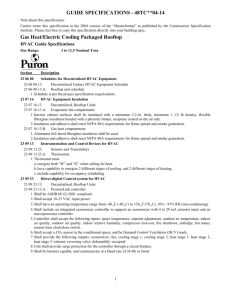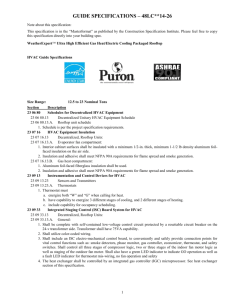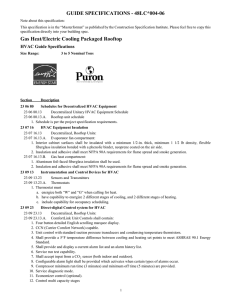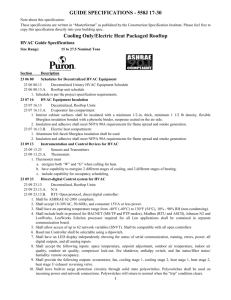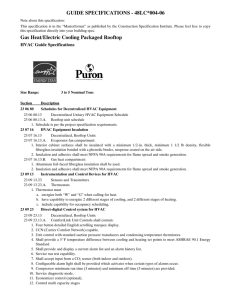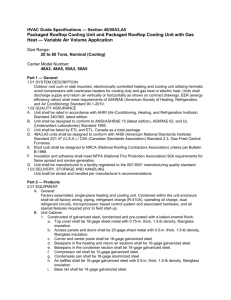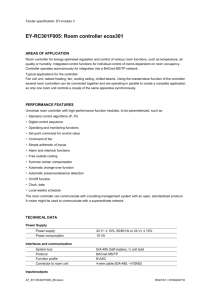GUIDE SPECIFICATIONS - 48tc*17-30
advertisement
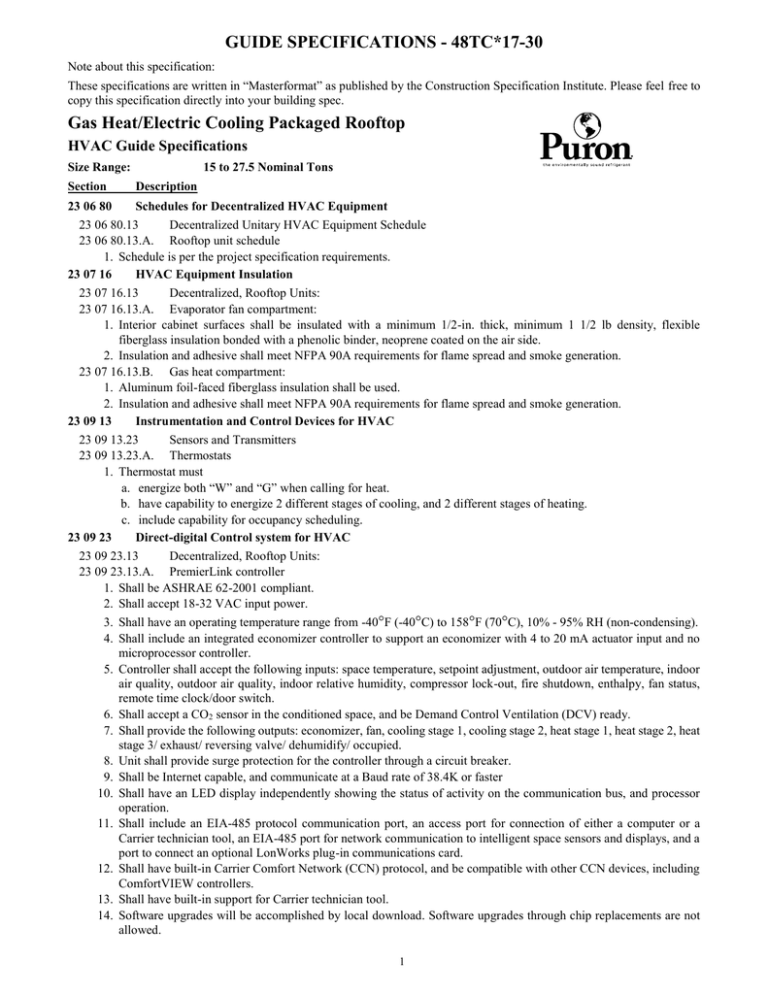
GUIDE SPECIFICATIONS - 48TC*17-30 Note about this specification: These specifications are written in “Masterformat” as published by the Construction Specification Institute. Please feel free to copy this specification directly into your building spec. Gas Heat/Electric Cooling Packaged Rooftop HVAC Guide Specifications Size Range: 15 to 27.5 Nominal Tons Section Description 23 06 80 Schedules for Decentralized HVAC Equipment 23 06 80.13 Decentralized Unitary HVAC Equipment Schedule 23 06 80.13.A. Rooftop unit schedule 1. Schedule is per the project specification requirements. 23 07 16 HVAC Equipment Insulation 23 07 16.13 Decentralized, Rooftop Units: 23 07 16.13.A. Evaporator fan compartment: 1. Interior cabinet surfaces shall be insulated with a minimum 1/2-in. thick, minimum 1 1/2 lb density, flexible fiberglass insulation bonded with a phenolic binder, neoprene coated on the air side. 2. Insulation and adhesive shall meet NFPA 90A requirements for flame spread and smoke generation. 23 07 16.13.B. Gas heat compartment: 1. Aluminum foil-faced fiberglass insulation shall be used. 2. Insulation and adhesive shall meet NFPA 90A requirements for flame spread and smoke generation. 23 09 13 Instrumentation and Control Devices for HVAC 23 09 13.23 Sensors and Transmitters 23 09 13.23.A. Thermostats 1. Thermostat must a. energize both “W” and “G” when calling for heat. b. have capability to energize 2 different stages of cooling, and 2 different stages of heating. c. include capability for occupancy scheduling. 23 09 23 Direct-digital Control system for HVAC 23 09 23.13 Decentralized, Rooftop Units: 23 09 23.13.A. PremierLink controller 1. Shall be ASHRAE 62-2001 compliant. 2. Shall accept 18-32 VAC input power. 3. Shall have an operating temperature range from -40°F (-40°C) to 158°F (70°C), 10% - 95% RH (non-condensing). 4. Shall include an integrated economizer controller to support an economizer with 4 to 20 mA actuator input and no microprocessor controller. 5. Controller shall accept the following inputs: space temperature, setpoint adjustment, outdoor air temperature, indoor air quality, outdoor air quality, indoor relative humidity, compressor lock-out, fire shutdown, enthalpy, fan status, remote time clock/door switch. 6. Shall accept a CO2 sensor in the conditioned space, and be Demand Control Ventilation (DCV) ready. 7. Shall provide the following outputs: economizer, fan, cooling stage 1, cooling stage 2, heat stage 1, heat stage 2, heat stage 3/ exhaust/ reversing valve/ dehumidify/ occupied. 8. Unit shall provide surge protection for the controller through a circuit breaker. 9. Shall be Internet capable, and communicate at a Baud rate of 38.4K or faster 10. Shall have an LED display independently showing the status of activity on the communication bus, and processor operation. 11. Shall include an EIA-485 protocol communication port, an access port for connection of either a computer or a Carrier technician tool, an EIA-485 port for network communication to intelligent space sensors and displays, and a port to connect an optional LonWorks plug-in communications card. 12. Shall have built-in Carrier Comfort Network (CCN) protocol, and be compatible with other CCN devices, including ComfortVIEW controllers. 13. Shall have built-in support for Carrier technician tool. 14. Software upgrades will be accomplished by local download. Software upgrades through chip replacements are not allowed. 1 15. Shall be shock resistant in all planes to 5G peak, 11ms during operation, and 100G peak, 11ms during storage. 16. Shall be vibration resistant in all planes to 1.5G @ 20-300 Hz. 17. Shall support a bus length of 4000 ft (1219m) max, 60 devices per 1000 ft (305m) section, and 1 RS-485 repeater per 1000 ft (305m) sections. 23 09 23.13.B. RTU Open protocol, direct digital controller: 1. Shall be ASHRAE 62-2001 compliant. 2. Shall accept 18-30VAC, 50-60Hz, and consumer 15VA or less power. 3. Shall have an operating temperature range from -40°F (-40°C) to 130°F (54°C), 10% - 90% RH (non-condensing). 4. Shall include built-in protocol for BACNET (MS/TP and PTP modes), Modbus (RTU and ASCII), Johnson N2 and LonWorks. LonWorks Echelon processor required for all Lon applications shall be contained in separate communication board. 5. Shall allow access of up to 62 network variables (SNVT). Shall be compatible with all open controllers 6. Baud rate Controller shall be selectable using a dipswitch. 7. Shall have an LED display independently showing the status of serial communication, running, errors, power, all digital outputs, and all analog inputs. 8. Shall accept the following inputs: space temperature, setpoint adjustment, outdoor air temperature, indoor air quality, outdoor air quality, compressor lock-out, fire shutdown, enthalpy switch, and fan status/filter status/ humidity/ remote occupancy. 9. Shall provide the following outputs: economizer, fan, cooling stage 1, cooling stage 2, heat stage 1, heat stage 2, heat stage 3/ exhaust/ reversing valve. 10. Shall have built-in surge protection circuitry through solid state polyswitches. Polyswitches shall be used on incoming power and network connections. Polyswitches will return to normal when the “trip” condition clears. 11. Shall have a battery back-up capable of a minimum of 10,000 hours of data and time clock retention during power outages. 12. Shall have built-in support for Carrier technician tool. 13. Shall include an EIA-485 protocol communication port, an access port for connection of either a computer or a Carrier technician tool, an EIA-485 port for network communication to intelligent space sensors and displays, and a port to connect an optional LonWorks communications card. 14. Software upgrades will be accomplished by either local or remote download. No software upgrades through chip replacements are allowed. 23 09 33 Electric and Electronic Control System for HVAC 23 09 33.13 Decentralized, Rooftop Units: 23 09 33.13.A. General: 1. Shall be complete with self-contained low-voltage control circuit protected by a resettable circuit breaker on the 24-v transformer side. Transformer shall have 75VA capability. 2. Shall utilize color-coded wiring. 3. Shall include a central control terminal board to conveniently and safely provide connection points for vital control functions such as: smoke detectors, phase monitor, gas controller, economizer, thermostat, DDC control options, and low and high pressure switches. 4. The heat exchanger shall be controlled by an integrated gas controller (IGC) microprocessor. See heat exchanger section of this specification. 5. Unit shall include a minimum of one 8-pin screw terminal connection board for connection of control wiring. 23 09 33.23.B. Safeties: 1. Compressor over-temperature, over-current. High internal pressure differential. 2. Low-pressure switch. a. Units shall have different sized connectors for the circuit 1 and circuit 2 low and high pressure switches. They shall physically prevent the cross-wiring of the safety switches between circuits 1 and 2. b. Low pressure switch shall use different color wire than the high pressure switch. The purpose is to assist the installer and service technician to correctly wire and or troubleshoot the rooftop unit. 3. High-pressure switch. a. Units shall have different sized connectors for the circuit 1 and circuit 2 low and high pressure switches. They shall physically prevent the cross-wiring of the safety switches between circuits 1 and 2. b. High pressure switch shall use different color wire than the low pressure switch. The purpose is to assist the installer and service technician to correctly wire and or troubleshoot the rooftop unit. 4. Automatic reset, motor thermal overload protector. 5. Heating section shall be provided with the following minimum protections: a. High-temperature limit switches. b. Induced draft motor speed sensor. 2 c. Flame rollout switch. d. Flame proving controls. 23 09 93 Sequence of Operations for HVAC Controls 23 09 93.13 Decentralized, Rooftop Units: 23 09 93.13 INSERT SEQUENCE OF OPERATION 23 40 13 Panel Air Filters 23 40 13.13 Decentralized, Rooftop Units: 23 40 13.13.A. Standard filter section 1. Shall consist of factory-installed, low velocity, disposable 2-in. thick fiberglass filters of commercially available sizes. 2. Unit shall use only one filter size. Multiple sizes are not acceptable. 3. Filters shall be accessible through a dedicated, weather tight access panel. 4. 4-in filter capabilities shall be capable with pre-engineered and approved Carrier filter track field installed accessory. This kit requires field furnished filters. 23 81 19 Self-Contained Air Conditioners 23 81 19.13 Medium-Capacity Self-Contained Air Conditioners (48TC*D17-30) 23 81 19.13.A. General 1. Outdoor, rooftop mounted, electrically controlled, heating and cooling unit utilizing a fully hermetic scroll compressor(s) for cooling duty and gas combustion for heating duty. 2. Factory assembled, single-piece heating and cooling rooftop unit. Contained within the unit enclosure shall be all factory wiring, piping, controls, and special features required prior to field start-up. 3. Unit shall use environmentally sound, Puron refrigerant. 4. Unit shall be installed in accordance with the manufacturer’s instructions. 5. Unit must be selected and installed in compliance with local, state, and federal codes. 23 81 19.13.B. Quality Assurance 1. Unit meets ASHRAE 90.1 minimum efficiency requirements. 2. Unit shall be rated in accordance with AHRI Standard 340/360. 3. Unit shall be designed to conform to ASHRAE 15. 4. Unit shall be ETL-tested and certified in accordance with ANSI Z21.47 Standards and ETL-listed and certified under Canadian standards as a total package for safety requirements. 5. Insulation and adhesive shall meet NFPA 90A requirements for flame spread and smoke generation. 6. Unit casing shall be capable of withstanding 500-hour salt spray exposure per ASTM B117 (scribed specimen). 7. Unit casing shall be capable of withstanding Federal Test Method Standard No. 141 (Method 6061) 5000-hour salt spray. 8. Unit shall be designed and manufactured in accordance with ISO 9001. 9. Roof curb shall be designed to conform to NRCA Standards. 10. Unit shall be subjected to a completely automated run test on the assembly line. The data for each unit will be stored at the factory, and must be available upon request. 11. Unit shall be designed in accordance with UL Standard 1995, including tested to withstand rain. 12. Unit shall be constructed to prevent intrusion of snow and tested to prevent snow intrusion into the control box up to 40 mph. 13. Unit shake tested to assurance level 1, ASTM D4169 to ensure shipping reliability. 14. High Efficient Motors listed shall meet section 313 of the Energy Independence and Security Act of 2007 (EISA 2007). 23 81 19.13.C. Delivery, Storage, and Handling 1. Unit shall be stored and handled per manufacturer’s recommendations. 2. Lifted by crane requires either shipping top panel or spreader bars. 3. Unit shall only be stored or positioned in the upright position. 23 81 19.13.D. Project Conditions 1. As specified in the contract. 23 81 19.13.E. Operating Characteristics 1. Unit shall be capable of starting and running at 115°F (46°C) ambient outdoor temperature, meeting maximum load criteria of AHRI Standard 340/360 at ± 10% voltage. 2. Compressor with standard controls shall be capable of operation down to 30°F (-1°C), ambient outdoor temperatures. Accessory winter start kit is necessary if mechanically cooling at ambient temperatures below 30°F (-1°C). 3. Unit shall discharge supply air vertically as shown on contract drawings. 4. Unit shall be factory configured and ordered for vertical supply & return configurations. 3 5. Unit shall be factory furnished for vertical configuration. No field conversion is required. 23 81 19.13.F. Electrical Requirements 1. Main power supply voltage, phase, and frequency must match those required by the manufacturer. 23 81 19.13.G. Unit Cabinet 1. Unit cabinet shall be constructed of galvanized steel, and shall be bonderized and coated with a pre-painted baked enamel finish on all externally exposed surfaces. 2. Unit cabinet exterior paint shall be: film thickness, (dry) 0.003 inches minimum, gloss (per ASTM D523, 60°F / 16°C): 60, Hardness: H-2H Pencil hardness. 3. Evaporator fan compartment interior cabinet insulation shall conform to AHRI Standard 340/360 minimum exterior sweat criteria. Interior surfaces shall be insulated with a minimum 1/2-in. thick, 1 lb density, flexible fiberglass insulation, neoprene coated on the air side. Aluminum foil-faced fiberglass insulation shall be used in the gas heat compartment. 4. Base of unit shall have a minimum of four locations for thru-the-base gas and electrical connections standard. Both gas and electric connections shall be internal to the cabinet to protect from environmental issues. 5. Base Rail a. Unit shall have base rails on a minimum of 2 sides. b. Holes shall be provided in the base rails for rigging shackles to facilitate maneuvering and overhead rigging. c. Holes shall be provided in the base rail for moving the rooftop by fork truck. d. Base rail shall be a minimum of 16 gauge thickness. 6. Condensate pan and connections: a. Shall be a sloped condensate drain pan made of a non-corrosive material. b. Shall comply with ASHRAE Standard 62. c. Shall use a 3/4-in -14 NPT drain connection, through the side of the drain pan. Connection shall be made per manufacturer’s recommendations. 7. Top panel: a. Shall be a multi-piece top panel linked with water tight flanges and locking systems. 8. Gas Connections: a. All gas piping connecting to unit gas valve shall enter the unit cabinet at a single location on side of unit (horizontal plane). b. Thru-the-base capability (1.) Standard unit shall have a thru-the-base gas-line location using a raised, embossed portion of the unit basepan. (2.) Thru-the-base provisions/connections are available as standard with every unit. When bottom connections are required, field furnished couplings are required. (3.) No basepan penetration, other than those authorized by the manufacturer, is permitted. 9. Electrical Connections a. All unit power wiring shall enter unit cabinet at a single, factory-prepared, knockout location. b. Thru-the-base capability. (1.) Thru-the-base provisions/connections are available as standard with every unit. When bottom connections are required, field furnished couplings are required. (2.) No basepan penetration, other than those authorized by the manufacturer, is permitted. 10. Component access panels (standard) a. Cabinet panels shall be easily removable for servicing. b. Unit shall have one factory installed, removable, filter access panel. c. Panels covering control box and filter shall have molded composite handles while the blower access door shall have an integrated flange for easy removal. d. Handles shall be UV modified, composite. They shall be permanently attached, and recessed into the panel. e. Screws on the vertical portion of all removable access panels shall engage into heat resistant, molded composite collars. f. Collars shall be removable and easily replaceable using manufacturer recommended parts. 23 81 19.13.H. Gas Heat 1. General a. Heat exchanger shall be an induced draft design. Positive pressure heat exchanger designs shall not be allowed. b. Shall incorporate a direct-spark ignition system and redundant main gas valve. c. Gas supply pressure at the inlet to the rooftop unit gas valve must match that required by the manufacturer. 2. The heat exchanger shall be controlled by an integrated gas controller (IGC) microprocessor. a. IGC board shall notify users of fault using an LED (light-emitting diode). 4 b. IGC board shall contain algorithms that modify evaporator-fan operation to prevent future cycling on high temperature limit switch. c. Unit shall be equipped with anti-cycle protection with one short cycle on unit flame rollout switch or 4 continuous short cycles on the high temperature limit switch. Fault indication shall be made using an LED. 3. Standard Heat Exchanger construction a. Heat exchanger shall be of the tubular-section type constructed of a minimum of 20-gauge steel coated with a nominal 1.2 mil aluminum-silicone alloy for corrosion resistance. b. Burners shall be of the in-shot type constructed of aluminum-coated steel. c. Burners shall incorporate orifices for rated heat output up to 2000 ft (610m) elevation. Additional accessory kits may be required for applications above 2000 ft (610m) elevation, depending on local gas supply conditions. d. Each heat exchanger tube shall contain multiple dimples for increased heating effectiveness. 4. Optional Stainless Steel Heat Exchanger construction a. Use energy saving, direct-spark ignition system. b. Use a redundant main gas valve. c. Burners shall be of the in-shot type constructed of aluminum-coated steel. d. All gas piping shall enter the unit cabinet at a single location on side of unit (horizontal plane). e. The optional stainless steel heat exchanger shall be of the tubular-section type, constructed of a minimum of 20-gauge type 409 stainless steel. f. Type 409 stainless steel shall be used in heat exchanger tubes and vestibule plate. g. Complete stainless steel heat exchanger allows for greater application flexibility. 5. Induced draft combustion motor and blower a. Shall be a direct-drive, single inlet, forward-curved centrifugal type. b. Shall be made from steel with a corrosion-resistant finish. c. Shall have permanently lubricated sealed bearings. d. Shall have inherent thermal overload protection. e. Shall have an automatic reset feature. 23 81 19.13.I. Coils 1. Standard Aluminum Fin - Copper Tube Coils: a. Standard evaporator and condenser coils shall have aluminum lanced plate fins mechanically bonded to seamless internally grooved copper tubes with all joints brazed. b. Evaporator coils shall be leak tested to 150 psig, pressure tested to 450 psig, and qualified to UL 1995 burst test at 1775 psig. c. Condenser coils shall be leak tested to 150 psig, pressure tested to 650 psig, and qualified to UL 1995 burst test at 1980 psig. 2. Optional Pre-coated aluminum-fin condenser coils: a. Shall have a durable epoxy-phenolic coating to provide protection in mildly corrosive coastal environments. b. Coating shall be applied to the aluminum fin stock prior to the fin stamping process to create an inert barrier between the aluminum fin and copper tube. c. Epoxy-phenolic barrier shall minimize galvanic action between dissimilar metals. 3. Optional Copper-fin evaporator and condenser coils: a. Shall be constructed of copper fins mechanically bonded to copper tubes and copper tube sheets. b. Galvanized steel tube sheets shall not be acceptable. c. A polymer strip shall prevent coil assembly from contacting the sheet metal coil pan to minimize potential for galvanic corrosion between coil and pan. 4. Optional E-coated aluminum-fin evaporator and condenser coils: a. Shall have a flexible epoxy polymer coating uniformly applied to all coil surface areas without material bridging between fins. b. Coating process shall ensure complete coil encapsulation of tubes, fins and headers. c. Color shall be high gloss black with gloss per ASTM D523-89. d. Uniform dry film thickness from 0.8 to 1.2 mil on all surface areas including fin edges. e. Superior hardness characteristics of 2H per ASTM D3363-92A and cross-hatch adhesion of 4B-5B per ASTM D3359-93. f. Impact resistance shall be up to 160 in.-lb (ASTM D2794-93). g. Humidity and water immersion resistance shall be up to minimum 1000 and 250 hours respectively (ASTM D2247-92 and ASTM D870-92). h. Corrosion durability shall be confirmed through testing to be no less than 1000 hours salt spray per ASTM B117-90. 5. Standard All Aluminum Novation Coils: 5 a. Standard condenser coils shall have all aluminum NOVATION Heat Exchanger Technology design consisting of aluminum multi port flat tube design and aluminum fin. Coils shall be a furnace brazed design and contain epoxy lined shrink wrap on all aluminum to copper connections. b. Condenser coils shall be leak tested to 150 psig, pressure tested to 650 psig, and qualified to UL 1995 burst test at 1980 psig. 6. Optional E-coated aluminum-fin, aluminum tube condenser coils: a. Shall have a flexible epoxy polymer coating uniformly applied to all coil external surface areas without material bridging between fins. b. Coating process shall ensure complete coil encapsulation, including all exposed fin edges. c. E-coat thickness of 0.8 to 1.2 mil with top coat having a uniform dry film thickness from 1.0 to 2.0 mil on all external coil surface areas, including fin edges, shall be provided. d. Shall have superior hardness characteristics of 2H per ASTM D3363-00 and cross-hatch adhesion of 4B-5B per ASTM D3359-02. e. Shall have superior impact resistance with no cracking, chipping or peeling per NSF/ANSI 51-2002 Method 10.2. 23 81 19.13.J. Refrigerant Components 1. Refrigerant circuit shall include the following control, safety, and maintenance features: a. Fixed orifice metering system (on non-Humidimizer units) shall prevent mal-distribution of two-phase refrigerant by including multiple fixed orifice devices in each refrigeration circuit. Each orifice is to be optimized to the coil circuit it serves. b. Thermostatic Expansion Valve (TXV) shall help provide optimum performance across the entire operating range. Shall contain removable power element to allow change-out of power element and bulb without removing the valve body (for Humidimizer units only). c. Refrigerant filter drier - Solid core design. d. Service gauge connections on suction and discharge lines. e. Pressure gauge access through a specially designed access screen on the side of the unit. 2. Compressors a. Unit shall use fully hermetic, scroll compressor for each independent refrigeration circuit. b. Models shall be available with 2 compressor/2-stage cooling. c. Compressor motors shall be cooled by refrigerant gas passing through motor windings. d. Compressors shall be internally protected from high discharge temperature conditions. e. Compressors shall be protected from an over-temperature and over-amperage conditions by an internal, motor overload device. f. Compressor shall be factory mounted on rubber grommets. g. Compressor motors shall have internal line break thermal, current overload and high pressure differential protection. h. Crankcase heaters shall not be required for normal operating range, unless provided by the factory. 23 81 19.13.K. Filter Section 1. Filters access is specified in the unit cabinet section of this specification. 2. Filters shall be held in place by a preformed, slide-out filter tray, facilitating easy removal and installation. 3. Shall consist of factory-installed, low velocity, throw-away 2-in. thick fiberglass filters. 4. Filters shall be standard, commercially available sizes. 5. Only one size filter per unit is allowed. 6. 4-in filter capability is possible with a field installed pre-engineered slide out filter track accessory. 4-in filters are field furnished. 23 81 19.13.L. Evaporator Fan and Motor 1. Evaporator fan motor: a. Shall have inherent automatic-reset thermal overload protection or circuit breaker. b. Shall have a maximum continuous bhp rating for continuous duty operation; no safety factors above that rating shall be required. 2. Belt-driven Evaporator Fan: a. Belt drive shall include an adjustable-pitch motor pulley and belt break protection system. b. Shall use rigid pillow block bearing system with lubricant fittings at accessible bearing or lubrication line. c. Blower fan shall be double-inlet type with forward-curved blades. d. Shall be constructed from steel with a corrosion resistant finish and dynamically balanced. 23 81 19.13.M. Condenser Fans and Motors 1. Condenser fan motors: a. Shall be a totally enclosed motor. 6 b. Shall use permanently lubricated bearings. c. Shall have inherent thermal overload protection with an automatic reset feature. d. Shall use a shaft-down design. 2. Condenser Fans: a. Shall be a direct-driven propeller type fan. b. Shall have galvalum blades riveted to corrosion-resistant steel spiders and shall be dynamically balanced. 23 81 19.13.N. Special Features Options and Accessories 1. Staged Air Volume System (SAV) for 2-stage cooling models only: a. Evaporator fan motor: (1.) Shall have permanently lubricated bearings. (2.) Shall have a maximum continuous bhp rating for continuous duty operation; no safety factors above that rating. (3.) Shall be Variable Frequency duty and 2-speed control. (4.) Shall contain motor shaft grounding ring to prevent electrical bearing fluting damage by safely diverting harmful shaft voltages and bearing currents to ground. 2. Variable Frequency Drive (VFD). Only available on 2-speed indoor fan motor option (SAV): a. Shall be installed inside the unit cabinet, mounted, wired and tested. b. Shall contain Electromagnetic Interference (EMI) frequency protection. c. Insulated Gate Bi-Polar Transistors (IGBT) used to produce the output pulse width modulated (PWM) waveform, allowing for quiet motor operation. d. Self diagnostics with fault and power code LED indicator. Field accessory Display Kit available for further diagnostics and special setup applications. e. RS485 capability standard. f. Electronic thermal overload protection. g. 5% swinging chokes for harmonic reduction and improved power factor. h. All printed circuit boards shall be conformal coated. 3. Standard Integrated Economizers: a. Integrated, gear-driven opposing blade design type capable of simultaneous economizer and compressor operation. b. Independent modules for vertical return configurations shall be available. Vertical return modules shall be available as a factory installed option or field installed accessory. c. Damper blades shall be galvanized steel with composite gears. Plastic or composite blades on intake or return shall not be acceptable. d. Shall include all hardware and controls to provide free cooling with outdoor air when temperature and/or humidity are below setpoints. e. Shall be equipped with gear driven dampers for both the outdoor ventilation air and the return air for positive air stream control. f. Standard models shall be equipped with low-leakage dampers, not to exceed 2% leakage at 1 in. wg pressure differential. Economizer controller on electromechanical units shall be Honeywell W7212 that provides: (1.) Combined minimum and DCV maximum damper position potentiometers with compressor staging relay. (2.) Functions with solid state analog enthalpy or dry bulb changeover control sensing. (3.) Contain LED indicates for: When free cooling is available When module is in DCV mode When exhaust fan contact is closed g. Ultra low leak EconoMi$er X system shall be available on models with SAV 2-speed Variable Frequency Drive (VFD) systems. Only available on 2-speed indoor fan motor systems with electromechanical controls or RTU Open. (1.) Maximum damper leakage rate to be equal to or less than 4.0 cfm/sq. ft. at 1.0 in. w.g., meeting or exceeding ASHRAE 90.1 requirements. Economizer controller on electromechanical units shall be Honeywell W7220 that provides: (2.) 2-line LCD interface screen for setup, configuration and troubleshooting. (3.) On-board fault detection and diagnostics (4.) Sensor failure loss of communication identification (5.) Automatic sensor detection (6.) Capabilities for use with multiple-speed indoor fan systems (7.) Utilize digital sensors: Dry bulb and Enthalpy h. Shall be capable of introducing up to 100% outdoor air. 7 4. 5. 6. 7. 8. 9. 10. 11. i. Shall be equipped with a barometric relief damper capable of relieving up to 100% return air. j. Shall be designed to close damper(s) during loss-of-power situations with spring return built into motor. k. Dry bulb outdoor air temperature sensor shall be provided as standard. Outdoor air sensor setpoint shall be adjustable and shall range from 40 to 100°F / 4 to 38°C. Additional sensor options shall be available as accessories. l. The economizer controller shall also provide control of an accessory power exhaust unit function. Factory set at 100%, with a range of 0% to 100%. m. The economizer shall maintain minimum airflow into the building during occupied period and provide design ventilation rate for full occupancy. A remote potentiometer may be used to override the damper setpoint. n. Dampers shall be completely closed when the unit is in the unoccupied mode. o. Economizer controller shall accept a 2-10 Vdc CO2 sensor input for IAQ/DCV control. In this mode, dampers shall modulate the outdoor air damper to provide ventilation based on the sensor input. p. Compressor lockout sensor shall open at 35°F (2°C) and close closes at 50°F (10°C). q. Actuator shall be direct coupled to economizer gear. No linkage arms or control rods shall be acceptable. r. Economizer controller shall provide indications when in free cooling mode, in the DCV mode, or the exhaust fan contact is closed. Two-Position Motorized Damper: a. Damper shall be a Two-Position Damper. Damper travel shall be from the full closed position to the field adjustable %-open setpoint. b. Damper shall include adjustable damper travel from 25% to 100% (full open). c. Damper shall include single or dual blade, gear driven dampers and actuator motor. d. Actuator shall be direct coupled to damper gear. No linkage arms or control rods shall be acceptable. e. Damper will admit up to 100% outdoor air for applicable rooftop units. f. Damper shall close upon indoor (evaporator) fan shutoff and/or loss of power. g. The damper actuator shall plug into the rooftop unit’s wiring harness plug. No hard wiring shall be required. h. Outside air hood shall include aluminum water entrainment filter. Manual damper a. Manual damper package shall consist of damper, air inlet screen, and rain hood which can be preset to admit up to 25% outdoor air for year round ventilation. Humidi-MiZer Adaptive Dehumidification System (not available on 30 size models): a. The Humidi-MiZer Adaptive Dehumidification System shall be factory-installed in 48TC17-28 models with RTPF (round tube plate fin) condenser coils, and shall provide greater dehumidification of the occupied space by two modes of dehumidification operations beside its normal design cooling mode: (1.) Subcooling mode further sub cools the hot liquid refrigerant leaving the condenser coil when both temperature and humidity in the space are not satisfied. (2.) Hot gas reheat mode shall mix a portion of the hot gas from the discharge of the compressor with the hot liquid refrigerant leaving the condenser coil to create a two-phase heat transfer in the system, resulting in a neutral leaving air temperature when only humidity in the space is not satisfied. (3.) Includes head pressure controller. Head Pressure Control Package (MotorMaster) a. Controller shall control coil head pressure by condenser-fan speed modulation or condenser-fan cycling and wind baffles. b. Shall consist of solid-state control and condenser-coil temperature sensor to maintain condensing temperature between 90°F (32°C) and 110°F (43°C) at outdoor ambient temperatures down to -20°F (-29°C). Propane Conversion Kit a. Package shall contain all the necessary hardware and instructions to convert a standard natural gas unit for use with liquefied propane. Kits shall be available for elevations from 0 up to 14,000 ft (4,267m). Condenser Coil Hail Guard Assembly a. Shall protect against damage from hail. b. Shall be louvered style design. Unit-Mounted, Non-Fused Disconnect Switch: a. Switch shall be factory-installed, internally mounted. b. National Electric Code (NEC) and UL approved non-fused switch shall provide unit power shutoff. c. Shall be accessible from outside the unit. d. Shall provide local shutdown and lockout capability. Convenience Outlet: a. Powered convenience outlet. (1.) Outlet shall be powered from main line power to the rooftop unit. 8 12. 13. 14. 15. 16. 17. 18. 19. 20. (2.) Outlet shall be powered from line side of disconnect by installing contractor, as required by code. If outlet is powered from load side of disconnect, unit electrical ratings shall be ETL certified and rated for additional outlet amperage. (3.) Outlet shall be factory-installed and internally mounted with easily accessible 115-v female receptacle. (4.) Outlet shall include 15 amp GFI receptacles with independent fuse protection. (5.) Voltage required to operate convenience outlet shall be provided by a factory-installed step-down transformer. (6.) Outlet shall be accessible from outside the unit. b. Non-Powered convenience outlet. (1.) Outlet shall be powered from a separate 115/120v power source. (2.) A transformer shall not be included. (3.) Outlet shall be factory-installed and internally mounted with easily accessible 115-v female receptacle. (4.) Outlet shall include 15 amp GFI receptacles with independent fuse protection. (5.) Outlet shall be accessible from outside the unit. Flue Discharge Deflector: a. Flue discharge deflector shall direct unit exhaust vertically instead of horizontally. b. Deflector shall be defined as a “natural draft” device by the National Fuel and Gas (NFG) code. Centrifugal Power Exhaust: a. Power exhaust shall be used in conjunction with an integrated economizer. b. Independent modules for vertical return configurations shall be available. c. Power exhaust shall be controlled by economizer controller operation. Exhaust fans shall be energized when dampers open past the 0-100% adjustable setpoint on the economizer control. Roof Curbs (Vertical): a. Full perimeter roof curb with exhaust capability providing separate air streams for energy recovery from the exhaust air without supply air contamination. b. Formed galvanized steel with wood nailer strip and shall be capable of supporting entire unit weight. c. Permits installation and securing of ductwork to curb prior to mounting unit on the curb. Adapter Curb (Vertical): a. Full perimeter – fully assembled and welded roof curb with exhaust capability providing separate air streams for energy recovery from the exhaust air without supply air contamination. b. Formed galvanized steel with wood nailer strip and shall be capable of supporting entire unit weight. c. Permits installation of new 48TC17-28 models to past Carrier design curb models: DP, DR, HJ, TM, and TJ. (Not for 48TJE024-028 models.) Check with Carrier sales expert of further details and information. High Altitude Gas Conversion Kit: a. Package shall contain all the necessary hardware and instructions to convert a standard natural gas unit to operate from 3,000-10,000 ft (914 to 3048m) elevation and 10,001-14,000 ft (3049-4267m) elevation. Outdoor Air Enthalpy Sensor: a. The outdoor air enthalpy sensor shall be used to provide single enthalpy control. When used in conjunction with a return air enthalpy sensor, the unit will provide differential enthalpy control. The sensor allows the unit to determine if outside air is suitable for free cooling. Return Air Enthalpy Sensor: a. The return air enthalpy sensor shall be used in conjunction with an outdoor air enthalpy sensor to provide differential enthalpy control. Indoor Air Quality (CO2) Sensor: a. Shall be able to provide demand ventilation indoor air quality (IAQ) control. b. The IAQ sensor shall be available in duct mount, wall mount, or wall mount with LED display. The setpoint shall have adjustment capability. Smoke detectors: a. Shall be a Four-Wire Controller and Detector. b. Shall be environmental compensated with differential sensing for reliable, stable, and drift-free sensitivity. c. Shall use magnet-activated test/reset sensor switches. d. Shall have tool-less connection terminal access. e. Shall have a recessed momentary switch for testing and resetting the detector. f. Controller shall include: (1.) One set of normally open alarm initiation contacts for connection to an initiating device circuit on a fire alarm control panel. (2.) Two Form-C auxiliary alarm relays for interface with rooftop unit or other equipment. 9 21. 22. 23. 24. 25. 26. Copyright (3.) One Form-C supervision (trouble) relay to control the operation of the Trouble LED on a remote test/reset station. (4.) Capable of direct connection to two individual detector modules. (5.) Can be wired to up to 14 other duct smoke detectors for multiple fan shutdown applications Winter start kit a. Shall contain a bypass device around the low pressure switch. b. Shall be required when mechanical cooling is required down to 25°F (-4°C). c. Shall not be required to operate on an economizer when below an outdoor ambient of 40°F (4°C). Time Guard a. Shall prevent compressor short cycling by providing a 5-minute delay (±2 minutes) before restarting a compressor after shutdown for any reason. b. One device shall be required per compressor. California OSHPD Seismic Certification Label (17-28 sizes only) a. Units meet the seismic capacity requirements of the International Code Council Evaluation Service (ICC-ES) document AC156 (Acceptance Criteria for Seismic Qualification by Shake-Table Testing of Nonstructural Components and Systems) and per International Building Code (IBC 2009) at an SDS (g) value of 2.00 z/h=1.0, Ip=1.5 and certified by independent structural engineers. b. Units shall include a certification label that meets the CA OSHPD Special Seismic Certification pre-approval labeling requirements on the external chassis of the unit. Display Kit for Variable Frequency Drive a. Kit allows the ability to access the VFD controller programs to provide special setup capabilities and diagnostics. b. Kit contains display module and communication cable. c. Display Kit can be permanently installed in the unit or used on any SAV system VFD controller as needed. Hinged Access Panels: a. Shall provide easy access through hinged access doors with vinyl coated door retainers. b. Shall be on major panels of – filter, control box and fan motor. Energy Demand System - EDS (field installed accessory): a. Shall utilize wireless network communication to optimize rooftop unit energy usage, up to 875 yds and up to 49 load controllers for each gateway. A wireless cellular signal shall be utilized to communicate energy information to/from the customer web portal. b. Shall utilize explicit algorithms to minimize rooftop electrical demand charges, customizable to each facility. c. Shall allow scheduling of rooftop units and provide a “staggered start” approach to minimize electrical consumption charges, customized to each facility. d. Scheduling, adjustments, and sub-metered electrical data shall be accessible through a web based customer portal. e. Shall provide demand response capability, including compliance with Open ADR protocol. f. Shall utilize an external 4-pole relay and an internal single pole relay. g. Shall use (2) split core transformers to provide real-time sub-metered electrical usage. 2013 Carrier Corp. D 7310 W. Morris St. D Indianapolis, IN 46231 Edition Date: 02/25/14 Manufacturer reserves the right to change, at any time, specifications and designs without notice and without obligations. 10 Catalog No: Replaces: GS-48TC-17-30-V-01 GS-48TC-15PD
